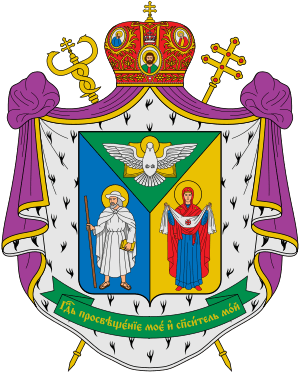Ukrainian Greek Catholic Church
The Ukrainian Greek Catholic Church (UGCC; Ukrainian Greek-Catholic Church: Українська Греко-Католицька Церква (УГКЦ), romanized: Ukrajins'ka hreko-katolic'ka cerkva, lit. 'Ukrainian Greek-Catholic Church'; Latin: Ecclesia Graeco-Catholica Ucrainae) is a Byzantine Rite Eastern Catholic Church in full communion with the Pope and the worldwide Catholic Church. It is the second-largest particular church (sui juris) in the Catholic Church (after the Latin, or Roman, Church). It is part of the Major Archiepiscopal Churches of the Catholic Church that are not distinguished with a patriarchal title.
Ukrainian Greek Catholic Church | |
|---|---|
| Ukrainian: Українська греко-католицька церква (УГКЦ) | |
St. George's Cathedral in Lviv, mother church of Ukrainian Greek Catholic Church | |
| Abbreviation | UGCC |
| Type | Particular church (sui iuris) |
| Classification | Eastern Catholic |
| Orientation | Eastern Christianity |
| Theology | Palamism[1] |
| Polity | Episcopal |
| Governance | Synod of the Ukrainian Catholic Church[2] |
| Pope | Francis |
| Major Archbishop | Sviatoslav Shevchuk[3] |
| Parishes | c. 3993 |
| Region | Mainly: Ukraine Minority: Canada, the United States, Australia, France, the United Kingdom, Germany, Brazil, Poland, Lithuania and Argentina. |
| Language | Ukrainian, Church Slavonic |
| Liturgy | Byzantine Rite |
| Headquarters | Cathedral of the Resurrection, Kiev, Ukraine |
| Founder | Grand Prince St. Volodymyr the Great (988 as the first who baptized Ruthenia) |
| Origin | 1596 Union of Brest Brest, Polish–Lithuanian Commonwealth |
| Separated from | Ecumenical Patriarchate of Constantinople (1596 as Ruthenian Uniate Church) |
| Separations | Ukrainian Orthodox Greek Catholic Church |
| Members | 5.5 million[4] |
| Other name(s) | Ukrainian Catholic Church Ukrainian Greek Church Uniate Church |
| Official website | ugcc |
| Part of a series on |
| Particular churches sui iuris of the Catholic Church |
|---|
Latin cross and Byzantine Patriarchal cross |
| Particular churches are grouped by rite. |
| Alexandrian Rite |
| Armenian Rite |
| Byzantine Rite |
| East Syriac Rite |
| Latin liturgical rites |
| West Syriac Rite |
|
|
| Ukrainian Greek Catholic Church |
|---|
| 1585 Union of Brest |
| 1839 Council of Polotsk |
| 1875 Conversion of Chełm Eparchy |
| 1946 Council of Lviv |
| Council for Religious Affairs |
| Anti-Catholicism in the Soviet Union |
| Eastern Catholic victims of Soviet persecutions |
The church is one of the successor churches to the acceptance of Christianity by Grand Prince Vladimir the Great of Kiev, in 988. It appeared in 1596 with the signing of the Union of Brest between the Ruthenian Orthodox Church (Polish–Lithuanian Commonwealth) led by Michael Rohoza and the Holy See.[5] Following the partitions of Poland, in 1808 the eparchies of the original Ruthenian Uniate Church (Latin: Ecclesia Ruthena unita)[6][7] were split three ways between the Austrian Empire (3), Prussia (1), and the Russian Empire (5). Those three eparchies under Austrian jurisdiction were reorganized as the Greek Catholic Church soon after liquidation of all five eparchies that ended up in Russia. Established in 1807 the Greek Catholic Church in Austria became the only survivor of the original Uniate church of the Brest Union.
In 1963 the church was recognized as Ukrainian through the efforts of Yosyf Slipyi.
The ordinary (or hierarch) of the church holds the title of Major archbishop of Kiev-Halych and All Ruthenia, though the hierarchs and faithful of the church have acclaimed their ordinary as "Patriarch" and have requested Papal recognition of, and elevation to, this title. Major archbishop is a unique title within the Catholic Church that was introduced in 1963 as part of political compromise. Since March 2011 the head of the church is Major Archbishop Sviatoslav Shevchuk.
The Ukrainian Greek Catholic Church is the largest Eastern Catholic Church in the world. Currently it has approximately 5.5 million members.[8] Within Ukraine itself, the UGCC is the second largest religious organization in terms of number of communities. In terms of number of members, the Ukrainian Greek Catholic Church ranks third in allegiance among the population of Ukraine after the Ukrainian Orthodox Church (Moscow Patriarchate) and the Orthodox Church of Ukraine. Currently, the Ukrainian Greek Catholic Church predominates in three western oblasts of Ukraine, including the majority of the population of Lviv, but constitutes a small minority elsewhere in the country. The church has followed the spread of the Ukrainian diaspora and now has some 40 hierarchs in over a dozen countries on four continents, including three other metropolitan bishops in Poland, the United States, and Canada.
History
Ruthenian Orthodox Church and previous attempts of Catholic Union
The Ruthenian Greek Catholic Church was created with the Union of Brest in 1595/1596, yet its roots go back to the very beginning of Christianity in the Mediaeval Slavic state of Ruthenia. Byzantine missionaries exercised decisive influence in the area. The 9th-century mission of Saints Cyril and Methodius in Great Moravia had particular importance as their work allowed the spread of worship in the Old Church Slavonic language. The Byzantine-Greek influence continued, particularly with the official adoption of Byzantine rites by Prince Vladimir I of Kiev in 988 when there was established the Ecumenical Patriarch of Constantinople Metropolis of Kiev and all Ruthenia. Later at the time of the Great Schism (ca 1054) the Ruthenian (Rusyn) Church took sides and remained Orthodox.
Following the devastating Mongol invasion of Ruthenia and sack of Kiev in 1240, Metropolitan Maximus of Kiev moved to the town of Vladimir-on-Klyazma in 1299. In 1303 on petition of Ruthenia kings from the Kingdom of Galicia–Volhynia (Ruthenia), Patriarch Athanasius I of Constantinople created a separate Metropolis of Halych that included western parishes of the original Metropolis of Kiev and all Ruthenia. The new metropolis did not last for long (inconsistently throughout most of the 14th century) and its new Metropolitan Peter of Moscow was consecrated as the Metropolitan of Kiev and all Ruthenia instead of Metropolitan of Halych. Just before his death Peter moved his episcopal see from Vladimir to Moscow. During his reign there was established Metropolitanate of Lithuania in the Grand Duchy of Lithuania, while after his death Metropolis of Halych was reestablished as well. In 1445 the Metropolitan Isidore with his see in Moscow joined the Council of Florence and became a papal legate of all Ruthenia and Lithuania. After Isidore suffered prosecutions by local bishops and royalty of the Grand Duchy of Moscow, he was banned away from Muscovy, while the Muscovite princes appointed own Metropolitan Jonah of Moscow without consent of the Ecumenical Patriarch of Constantinople.
Because of that Patriarch Gregory III of Constantinople reorganized the Ruthenian Church in the Polish–Lithuanian Commonwealth (until 1569 the Grand Duchy of Lithuania) and its new primates were titled as Metropolitans of Kiev, Halych and all Ruthenia. He appointed Gregory II Bulgarian as the new Greek Catholic primate who in 1470 rejoined the Ecumenical Patriarch of Constantinople under Dionysius I of Constantinople.
Ruthenian Uniate Church

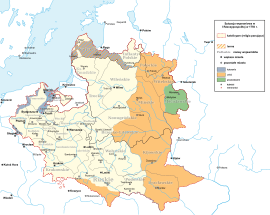
Latin Catholic
Greek Catholic
This situation continued for some time, and in the intervening years what is now Western and Central Ukraine came under the rule of the Polish–Lithuanian Commonwealth. The Polish king Sigismund III Vasa was heavily influenced by the ideals of the Counter-Reformation and wanted to increase the Catholic presence in Ukraine. Meanwhile, the clergy of the Ruthenian lands were ruled from distant Constantinople, and much of the population was loyal to Ruthenian Orthodoxy rather than to the Polish Catholic monarch. Persecution of the Orthodox population grew, and under pressure of Polish authorities the clergy of the Ruthenian Church agreed by the Union of Brest in 1595 to break from the Patriarchate of Constantinopole and unite with the Catholic Church under the authority of the ruler of the Commonwealth, Sigismund III Vasa, in exchange for ending the persecution. In an effort to stop further Polonization processes and recent recognition of the Moscow Patriarchate by Jeremias II of Constantinople, in 1596 the Ruthenian Orthodox Church signed the agreement with the Holy See.[5] The union was not accepted by all the members of the Ruthenian Orthodox Church in these lands, and marked the creation of Greek Catholic Church and separate eparchies that continued to stay Orthodox among which were Lviv eparchy, Peremyshel eparchy, Mukachevo eparchy and Lutsk eparchy that at first accepted the union but later oscillated back and forth.
The conflict between Orthodox and Greek Catholics tried to be extinguished by adopting "Articles for Pacification of Ruthenian people" in 1632.[9] Following that in the Polish–Lithuanian Commonwealth legally existed both churches with Metrolopolitans of Kiev, one, Josyf Veliamyn Rutsky, Greek Catholic, and another, Peter Mogila, Orthodox.
Partitions of the Commonwealth and the Uniate church in Russia, Prussia, and Austria
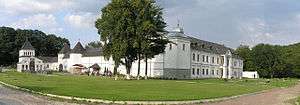
Following partitions of Poland, the Habsburg Monarchy established its crown land of the Kingdom of Galicia and Lodomeria and then West Galicia which in 1803 was merged with Galicia and Lodomeria, which became in 1804 the crownland of the Austrian Empire. The Greek Catholic Church was established on 1807 with metropolitan see based in Lwow and its suffragan dioceses included Chelm and Przemyśl.[10] Following the 1809 Treaty of Schönbrunn the Austrian Empire was forced to cede territory of former West Galicia to Duchy of Warsaw which in 1815 on decision of Congress of Vienna was ceded to the Russian Empire. The Chelm diocese which was located on the territory that for short period time was known as West Galicia ended up under the Russian jurisdiction.
The Russian emperor Pavel I of Russia restored the Uniate church which was reorganized with three eparchies suffragan to metropolitan bishop Joasaphat Bulhak.[11] The church was allowed to function without restraint (calling its adherents Basilians). However the clergy soon split into pro-Catholic and pro-Russian, with the former tending to convert to Latin Rite Catholicism, whilst the latter group, led by Bishop Iosif Semashko (1798–1868)[12] and firmly rejected by the ruling Greek-Catholic synod remained largely controlled by the pro-Polish clergy with the Russian authorities largely refusing to interfere. Following the Congress of Vienna, the Russian Empire occupied former Austrian Poland of so-called West Galicia and, temporarily, Tarnopol district, where in 1809 was established a separate metropolitan of Galicia. The territory of Kholm eparchy along with Central Polish territories became part of the Congress of Poland. The situation changed abruptly following Russia's successful suppression of the 1831 Polish uprising, aimed at overthrowing Russian control of the Polish territories. As the uprising was actively supported by the Greek-Catholic church, a crackdown on the Church occurred immediately. The pro-Latin members of the Synod were removed; and the Church began to disintegrate, with its parishes in Volhynia reverting to Orthodoxy, including the 1833 transfer of the famous Pochaiv Lavra. In 1839 the Synod of Polotsk (in modern-day Belarus), under the leadership of Bishop Semashko, dissolved the Greek-Catholic church in the Russian Empire, and all its property was transferred to the Orthodox state church. The 1913 Catholic Encyclopedia says that in what was then known as 'Little Russia' (now Ukraine), the pressure of the Russian Government "utterly wiped out" Greek Catholicism, and "some 7,000,000 of the Uniats there were compelled, partly by force and partly by deception, to become part of the Greek Orthodox Church".[13]
The dissolution of the Greek-Catholic Church in Russia was completed in 1875 with the abolition of the Eparchy of Kholm.[14] By the end of the century, those remaining faithful to this church began emigrating to the U.S., Canada, and Brazil due to persecution by the Orthodox Church and the Russian Empire, e.g. the Pratulin Martyrs.
The territory received by Austria-Hungary in the partition of Poland included Galicia (modern western Ukraine and southern Poland). Here the Greek-Catholic Ruthenian (Ukrainian) peasantry had been largely under Polish Catholic domination. The Austrians granted equal freedom of worship to the Greek-Catholic Church and removed Polish influence. They also mandated that Uniate seminarians receive a formal higher education (previously, priests had been educated informally by their fathers), and organized institutions in Vienna and Lviv that would serve this function. This led to the appearance, for the first time, of a large, educated class within the Ukrainian population in Galicia.[15] It also engendered a fierce sense of loyalty to the Habsburg dynasty. When Polish rebels briefly took control of Lviv in 1809, they demanded that the head of the Ukrainian Greek Catholic Church, Anton Anhelovych, substitute Napoleon's name in the Divine Liturgy for that of Austrian Emperor Francis II. Anhelovych refused, and was imprisoned. When the Austrians retook control over Lviv, Anhelovych was awarded the cross of Leopold by the Emperor.[16]
As a result of the reforms, over the next century the Greek-Catholic Church in Austrian Galicia ceased being a puppet of foreign interests and became the primary cultural force within the Ukrainian community. Most independent native Ukrainian cultural and political trends (such as Rusynophilia, Russophilia and later Ukrainophilia) emerged from within the ranks of the Greek-Catholic Church clergy. The participation of Greek Catholic priests or their children in western Ukrainian cultural and political life was so great that western Ukrainians were accused of wanting to create a theocracy in western Ukraine by their Polish rivals.[17] Among the political trends that emerged, the Christian social movement was particularly linked to the Ukrainian Catholic Church. Many people saw the Austrians as having saved the Ukrainians and their Church from the Poles, though it was the Poles who set into motion the Greek-Catholic cast of their church.

Soviet annexation of the Eastern Poland and liquidation of the Church
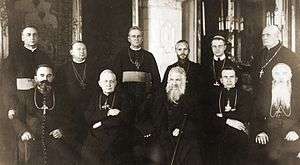
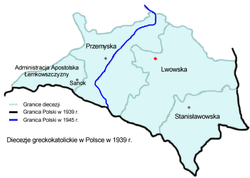
After World War I, Ukrainian Greek Catholics found themselves under the governance of the nations of Poland, Hungary, Romania and Czechoslovakia. Under the previous century of Austrian rule, the Ukrainian Greek Catholic Church attained such a strong Ukrainian national character that in interwar Poland, the Greek Catholics of Galicia were seen by the nationalist Polish and Catholic state as even less patriotic than the Orthodox Volhynians. Extending its Polonization policies to its Eastern Territories, the Polish authorities sought to weaken the UGCC. In 1924, following a visit with Ukrainian Catholic believers in North America and western Europe, the head of the UGCC was initially denied reentry to Lwów (the Polish name at the time for Lviv), only being allowed back after a considerable delay. Polish Catholic priests, led by their Latin bishops, began missionary work among Greek Catholics; and administrative restrictions were placed on the Ukrainian Greek Catholic Church.[19]
After World War II Ukrainian Catholics came under the rule of Communist Poland and the hegemony of the Soviet Union. With only a few clergy invited to attend, a synod was convened in Lviv (Lvov), which revoked the Union of Brest. Officially all of the church property was transferred to the Russian Orthodox Church under the Moscow Patriarchate,[20] Most of the Ukrainian Greek Catholic clergy went underground. This catacomb church was strongly supported by its diaspora in the Western Hemisphere. Emigration to the U.S. and Canada, which had begun in the 1870s, increased after World War II.
In the winter of 1944–1945, Ukrainian Greek Catholic clergy were summoned to 'reeducation' sessions conducted by the NKVD. Near the end of the war in Europe, the state media began an anti-Ukrainian-Catholic campaign.[21] The creation of the community in 1596 was discredited in publications, which went to great pains to try to prove the Church was conducting activities directed against Ukrainians in the first half of the 20th century.[21]
In 1945 Soviet authorities arrested, deported, and sentenced to forced-labor camps in Siberia and elsewhere the church's metropolitan Yosyf Slipyi and nine other Greek Catholic bishops, as well as hundreds of clergy and leading lay activists. In Lviv alone, 800 priests were imprisoned.[21] All the above-mentioned bishops and significant numbers of clergymen died in prisons, concentration camps, internal exile, or soon after their release during the post-Stalin thaw.[22] The exception was metropolitan Yosyf Slipyi who, after 18 years of imprisonment and persecution, was released thanks to the intervention of Pope John XXIII, Slipyi took refuge in Rome, where he received the title of Major Archbishop of Lviv, and became a cardinal in 1965.[22]
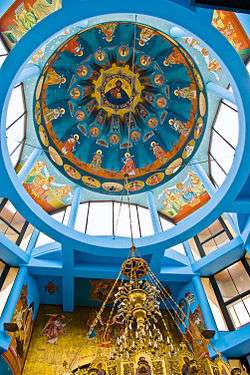
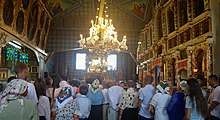
The clergy who joined the Russian Orthodox Church were spared the large-scale persecution of religion that occurred elsewhere in the country (see Religion in the Soviet Union). In the city of Lviv, only one church was closed (at a time when many cities in the rest of Ukraine did not have a working church). Moreover, the western dioceses of Lviv-Ternopil and Ivano-Frankivsk were the largest in the USSR and contained the majority of the Russian Orthodox Church's cloisters (particularly convents, of which there were seven in Ukrainian SSR but none in Russia). Orthodox canon law was also relaxed on the clergy allowing them to shave beards (a practice uncommon to Orthodoxy) and conduct liturgy in Ukrainian as opposed to Church Slavonic.
The Ukrainian Catholics continued to exist underground for decades and were the subject of vigorous attacks in the state media. The clergy gave up public exercise of their clerical duties, but secretly provided services for many lay people.[21] Many priests took up civilian professions and celebrated the sacraments in private. The identities of former priests could have been known to the Soviet police who regularly watched them, interrogated them and put fines on them, but stopped short of arrest unless their activities went beyond a small circle of people.[21] New secretly ordained priests were often treated more harshly.[21]
The church even grew during this time, and this was acknowledged by Soviet sources. The first secretary of the Lvov Komsomol, Oleksiy Babiychuk, claimed:
in this oblast, particularly in the rural areas, a large number of the population adheres to religious practices, among them a large proportion of youth. In the last few years, the activity of the Uniates [Ukrainian Catholics] has grown, that of representatives of the Uniates as well as former Uniate priests; there are even reverberations to renew the overt activity of this Church.[21]
After Stalin died, Ukrainian Catholics hoped this would lead to better conditions for themselves, but such hopes were dashed in the late 1950s when the authorities arrested even more priests and unleashed a new wave of anti-Catholic propaganda.[21] Secret ordinations occurred in exile. Secret theological seminaries in Ternopol and Kolomyia were reported in the Soviet press in the 1960s when their organizers were arrested.[21] In 1974 a clandestine convent was uncovered in Lviv.[21]
During the Soviet era, the Ukrainian Greek Catholic Church did flourish throughout the Ukrainian diaspora. Cardinal Yosyf Slipyi was jailed as a dissident but named in pectore (in secret) a cardinal in 1949; he was freed in 1963 and was the subject of an extensive campaign to have him named as a patriarch, which met with strong support as well as controversy. Pope Paul VI demurred, but compromised with the creation of a new title of major archbishop (assigned to Yosyf Slipyi on 23 December 1963[24] ), with a jurisdiction roughly equivalent to that of a patriarch in an Eastern church. This title has since passed to Myroslav Ivan Lubachivsky in 1984 and thereafter to Lubomyr Husar in 2000 and Sviatoslav Shevchuk in 2011; this title has also been granted to the heads of three other Eastern Catholic Churches.
In 1968, when the Ukrainian Catholic Church was legalized in Czechoslovakia, a large scale campaign was launched to harass recalcitrant clergy who remained illegal.[21] These clergy were subject to interrogations, fines and beatings. In January 1969 the KGB arrested an underground Catholic bishop named Vasyl Velychkovsky and two Catholic priests, and sentenced them to three years of imprisonment for breaking anti-religious legislation.[21]
Activities that could lead to arrest included holding religious services, educating children as Catholics, performing baptisms, conducting weddings or funerals, hearing confessions or giving the last rites, copying religious materials, possessing prayer books, possessing icons, possessing church calendars, possessing religious books or other sacred objects.[21] Conferences were held to discuss how to perfect the methodology in combatting Ukrainian Catholicism in West Ukraine.[21]
At times the Ukrainian Catholics attempted to employ legal channels to have their community recognized by the state. In 1956–1957 there were petitions to the proper authorities to request for churches to be opened. More petitions were sent in the 60s and 70s, all of which were refused. In 1976, a priest named Volodymyr Prokipov was arrested for presenting such a petition to Moscow.[21] The response to these petitions by the state had been to sharpen attacks against the community.
In 1984 a samizdat Chronicle of the Catholic Church began to be published by Ukrainian Catholics. The founder of the group behind this publication, Yosef Terelya, was arrested in 1985 and sentenced to seven years imprisonment and five years of exile.[21] His successor, Vasely Kobryn, was arrested and sentenced to three years of exile.[21]
The Solidarity movement in Poland and Pope John Paul II supported the Ukrainian Catholics. The state media attacked John Paul II. The antireligious journal Liudyna i Svit (Man and the World) published in Kiev wrote:
Proof that the Church is persistently striving to strengthen its political influence in socialist countries is witnessed by the fact that Pope John Paul II gives his support to the emigre hierarchy of the so-called Ukrainian Catholic Church . . .. The current tactic of Pope John Paul II and the Roman Curia lies in the attempts to strengthen the position of the Church in all socialist countries as they have done in Poland, where the Vatican tried to raise the status of the Catholic Church to a state within a state. In the last few years, the Vatican has paid particular attention to the question of Catholicism of the Slavonic nations. This is poignantly underscored by the Pope when he states that he is not only a Pope of Polish origin, but the first Slavic Pope, and he will pay particular attention to the Christianization of all Slavic nations.[21]
By the late 1980s there was a shift in the Soviet government's attitude towards religion. At the height of Mikhail Gorbachev's liberalization reforms the Ukrainian Greek Catholic Church was allowed again to function officially in December 1989.[20] But then it found itself largely in disarray with the nearly all of its pre-1946 parishes and property lost to the Orthodox faith. The church, actively supported by nationalist organizations such as Rukh and later the UNA-UNSO, took an uncompromising stance towards the return of its lost property and parishes. According to a Greek-Catholic priest, "even if the whole village is now Orthodox and one person is Greek Catholic, the church [building] belongs to that Catholic because the church was built by his grandparents and great-grandparents."[25] The weakened Soviet authorities were unable to pacify the situation, and most of the parishes in Galicia came under the control of the Greek-Catholics during the events of a large scale inter-confessional rivalry that was often accompanied by violent clashes of the faithful provoked by their religious and political leadership.[26] These tensions led to a rupture of relations between the Moscow Patriarchate and the Vatican.
Current situation
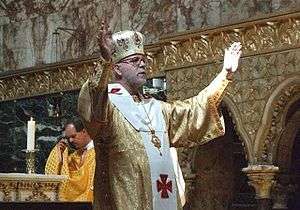
National surveys conducted since 2000 show that between 5.3% and 9.4% of Ukraine's total population are of the Ukrainian Greek Catholic Church.[27][28][29] In surveys, 18.6-21.3% of believers or religious people in Ukraine were Greek Catholic.[30][31] Worldwide, the faithful now number some 6 to 10 million, forming the largest particular Catholic Church, after the majority Latin Rite Church.
According to a 2015 survey, followers of the Ukrainian Greek Catholic Church make up 8.1% of the total population (excluding Crimea) and form the majority in 3 oblasts:[32]

- Lviv Oblast — 59% of the population
- Ivano-Frankivsk Oblast — 57%
- Ternopil Oblast — 52%
Today, most Ukrainian Catholic Churches have moved away from Church Slavonic and use Ukrainian. Many churches also offer liturgies in a language of the country the Church is in, for example, German in Germany or English in Canada; however, some parishes continue to celebrate the liturgy in Slavonic even today, and services in a mix of languages are not unusual.
In the early first decade of the 21st century, the major see of the Ukrainian Catholic Church was transferred to the Ukrainian capital of Kiev. The enthronement of the new head of the church Major Archbishop Sviatoslav Shevchuk took place there on 27 March 2011 at the cathedral under construction on the left bank. On 18 August 2013, the Patriarchal Cathedral of the Resurrection of Christ was dedicated and solemnly opened.
On 5 July 2019, Pope Francis declared to the church's leaders during a meeting in the Vatican “I hold you in my heart, and I pray for you, dear Ukrainian brothers."[33] He also advocated greater humanitarian aid to Ukraine and warned the Church's Bishops to show "closeness" to their "faithful."[33] The Pope also told the Church leaders to that "fruitful" unity within the Church can be achieved through three important aspects of synodality: listening; shared responsibility; and the involvement of the laity.[33]
De-Latinization and protest
The Ukrainian Greek Catholic Church previously embarked on a campaign of de-Latinization reforms. These include the removal of the stations of the cross, the rosary, and the monstrance from their liturgy and parishes. In 2001 a priest, Basil Kovpak, and a small group of followers opposed to certain policies (such as de-Latinization) and ecumenism of the UGCC hierarchy, organized themselves as the Priestly Society of Saint Josaphat (SSJK). The SSJK possesses close ties with the Latin Rite Traditionalist Catholic Society of Saint Pius X, which rejects and condemns certain actions and policies of both Husar and the Pope. On 21 November 2007 the Congregation for the Doctrine of the Faith excommunicated Kovpak.[34]
Critics claim that the SSJK's liturgical practice favours severely abbreviated services and imported Catholic devotions over the traditional and authentic practices of the Ukrainian Greek Catholic Church. Proponents counter that these symbols and rituals, influenced long ago by their Polish Latin Catholic neighbors, have been practiced by Ukrainian Greek Catholics for centuries. To deny them today is to deprive the people of a part of sacred heritage which they have learned to regard as their own.
In 2008, a group of Basilian priests from Slovakia after relocated to the Pidhirtsi monastery declared that four of them had been consecrated bishops without permission of the Pope or the Major Archbishop. The "Pidhirtsi fathers" had opposed de-latinization, liberal theology, and the ecumenical approach of the hierarchy. Excommunicated in 2008, in 2009 they constituted themselves as the Ukrainian Orthodox Greek Catholic Church calling the Ukrainian Greek Catholic Church "heretical".
Administration
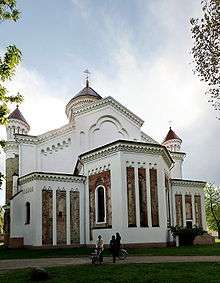
Ruthenian Uniate (eparchies) and partition of Poland
- Vilno archeparchy (Metropolitan of Kiev) → Russia
- Polotsk archeparchy (Polotsk) → Russia
- Smolensk archeparchy (Smolensk) → Russia
- Lutsk-Ostroh eparchy (Lutsk) → Russia
- Turow-Pinsk eparchy (Pinsk) → Russia
- Volodymyr-Brest eparchy (Volodymyr) → Suprasl eparchy in Germany
- Halych-Kamianets eparchy (Lviv) → Lemberg archeparchy (Metropolitan of Galicia) in Austria
- Chelm-Belz eparchy (Chelm) → Austria
- Przemysl-Sanok eparchy (Przemysl) → Austria
Greek Catholic church after the 1839 Synod of Polotsk
- Archeparchy of Lemberg (Lviv, Metropolitan of Galicia)
- Eparchy of Kulm and Belz (Chelm) → territory lost due to Congress of Vienna
- Eparchy of Premissel and Saanig (Przemysl)
- added eparchy of Stanislau (Ivano-Frankivsk)
- added apostolic exarchate of Lemkowszczyna (Sanok)
Cathedrals
- Ruthenian Uniate Church
(governing title Metropolitan of Kiev, Galicia and all Ruthenia)
- 1609-1746 Cathedral of the Theotokos, Vilnius by Hypatius Pociej
- 1746-1809 Cathedral of Saint Trinity,[35] Radomyshl
- Ukrainian Greek Catholic Church
(governing title Metropolitan of Galicia, since 2005 – Major Archbishop of Kiev-Galicia)
- 1816-1946 St. George's Cathedral, Lviv
- 1946-1989 Church liquidated by Soviet authorities (preserved on efforts of Josyf Slipyj at Santa Sofia a Via Boccea)
- 1989-2011 St. George's Cathedral, Lviv
- 2011–present Patriarchal Cathedral of the Resurrection of Christ, Kiev
Current administrative division
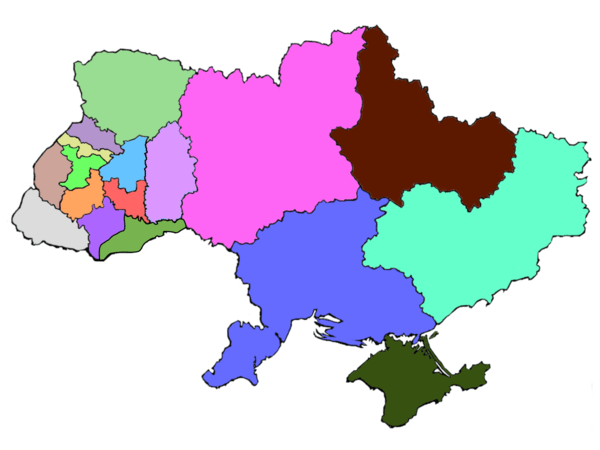
Mukachevo*
Note: The Eparchy of Mukachevo belongs to the Ruthenian Catholic Church rather than the Ukrainian Greek church.
The Ukrainian Greek Catholic Church moved its administrative center from Western Ukrainian Lviv to a new cathedral in Kiev on 21 August 2005. The title of the head of the UGCC was changed from The Major Archbishop of Lviv to The Major Archbishop of Kyiv and Halych.
The Patriarchal Curia of the Ukrainian Greek-Catholic Church is an organ of Sviatoslav Shevchuk, the head of the UGCC, Major Archbishop of Kyiv and Halych, which coordinates and promotes the common activity of the UGCC in Ukraine to make influence on society in different spheres: education, policy, culture, etc. The Curia develops action of the Church's structures, enables relations and cooperation with other Churches and major public institutions in religious and social areas for implementation of the Social Doctrine of the Catholic Church through everyday life.
In 2011 the church introduced territorial subdivisions in Ukraine, metropolia.[36] A metropolitan bishop, an archbishop of main archeparchy, may gather own metropolitan synod, decisions of which shall be approved by the Major Archbishop.[36]
The current eparchies and other territorial jurisdictions of the church are:
.jpg)
- Major Archbishop Svyatoslav Shevchuk
- Ukrainian Catholic Metropolitan of Kiev – Galicia (2005)[36]
- Ukrainian Catholic Archeparchy of Kyiv (Latin: Archidioecesis Kioviensis, previously as uniate diocese, 1996)
- Ukrainian Catholic Archiepiscopal Exarchate of Donetsk (2002)
- Ukrainian Catholic Archiepiscopal Exarchate of Odessa (2003)
- Ukrainian Catholic Archiepiscopal Exarchate of Lutsk (previously as uniate diocese, 2008)
- Ukrainian Catholic Archiepiscopal Exarchate of Crimea (2014 as administration in Odessa)
- Ukrainian Catholic Archiepiscopal Exarchate of Kharkiv (2014)
- Ukrainian Catholic Metropolitan of Lviv (1808 – 2005, 2011)[36]
- Ukrainian Catholic Archeparchy of Lviv (Latin: Archidioecesis Leopolitana Ucrainorum, 1539 – 1946, 1989)
- Ukrainian Catholic Eparchy of Sambir–Drohobych (1993)
- Ukrainian Catholic Eparchy of Zboriv (1993 – 2000)
- Ukrainian Catholic Eparchy of Stryi (2000)
- Ukrainian Catholic Eparchy of Sokal–Zhovkva (2000)
- Ukrainian Catholic Metropolitan of Ternopil – Zboriv (2011)[36]
- Ukrainian Catholic Archeparchy of Ternopil–Zboriv (1993)
- Ukrainian Catholic Eparchy of Buchach (2000)
- Ukrainian Catholic Eparchy of Kamyanets-Podilskyi (previously as united diocese, 2015)
- Ukrainian Catholic Metropolitan of Ivano-Frankivsk (2011)[36]
- Ukrainian Catholic Archeparchy of Ivano-Frankivsk (1885 – 1946, 1989)
- Ukrainian Catholic Eparchy of Kolomyia (1993)
- Ukrainian Catholic Eparchy of Chernivtsi (2017)
- Ukrainian Catholic Metropolitan of Przemyśl–Warsaw (Poland, 1996)[36]
- Ukrainian Catholic Archeparchy of Przemyśl–Warsaw (1087 – 1946, 1996)
- Ukrainian Catholic Eparchy of Wrocław-Gdańsk (1996)
- Ukrainian Catholic Metropolitan of Winnipeg (Canada, 1956)[36]
- Ukrainian Catholic Archeparchy of Winnipeg (1912)
- Ukrainian Catholic Eparchy of Edmonton (1948)
- Ukrainian Catholic Eparchy of Toronto and Eastern Canada (1948)
- Ukrainian Catholic Eparchy of Saskatoon (1951)
- Ukrainian Catholic Eparchy of New Westminster (1974)
- Ukrainian Catholic Metropolitan of Philadelphia (United States, 1958)[36]
- Ukrainian Catholic Archeparchy of Philadelphia (1913)
- Ukrainian Catholic Eparchy of Stamford (1956)
- Ukrainian Catholic Eparchy of Chicago (1961)
- Ukrainian Catholic Eparchy of Parma (1983)
- Ukrainian Catholic Metropolitan of Curitiba (Brazil, 2014)
- Ukrainian Catholic Archeparchy of Curitiba (1962)
- Ukrainian Catholic Eparchy of Prudentópolis (2014)
- Ukrainian Catholic Eparchy of Buenos Aires (Argentina, 1968)
- Ukrainian Catholic Eparchy of Melbourne (Australia, New Zealand and Oceania, 1958)
- Ukrainian Catholic Eparchy of the Holy Family of London (England, Scotland and Wales, 1957)
- Ukrainian Catholic Eparchy of Saint Wladimir-Le-Grand de Paris (France, Switzerland and Benelux, 1960)
- Ukrainian Catholic Apostolic Exarchate of Germany and Scandinavia* (1959)
- Ukrainian Catholic Apostolic Exarchate of Italy* (2019)
- Ukrainian Catholic Metropolitan of Kiev – Galicia (2005)[36]
* Directly subject to the Holy See
As of 2014, the Ukrainian Greek Catholic Church is estimated to have 4,468,630 faithful, 39 bishops, 3993 parishes, 3008 diocesan priests, 399 religious-order priests, 818 men religious, 1459 women religious, 101 deacons, and 671 seminarians.[37]
Monastic orders and religious congregations
List of orders and congregations[38]
Male
- Order of Saint Basil the Great
- Studite Brethren
- Congregation of the Most Holy Redeemer
- Congregation of the Salesian Fathers of St. Don Bosco
- Miles Jesu
- Missionary Congregation of Saint Andrew the Apostle
Female
- Sisters of the Order of Saint Basil the Great
- Sisters Servants of Mary Immaculate
- Sisters of St. Joseph, the Spouse of the Virgin Mary (related to Sisters of St. Joseph)
- Sisters Catechists of Saint Anne (related to Sisters of Saint Anne)
- Sisters of the Holy Family
- Sisters of the Priest and Martyr St. Josaphat Kuntsevych
- Sisters of Mercy of St. Vincent de Paul (related to Daughters of Charity of Saint Vincent de Paul)
- Salesian Sisters
- Sisters of the Most Holy Eucharist
- Myrrh-bearing Sisters under the Protection of St. Mary Magdalene
Prison ministry of the Ukrainian Greek-Catholic Church
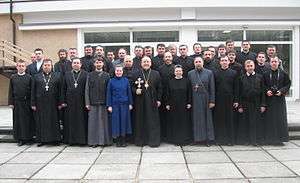
In contemporary Ukraine prison ministry of chaplains does not exist de jure. The prison pastoral care was at the very heart of the spirituality of the Ukrainian Greek-Catholic Church throughout her history. Prison Pastoral of the UGCC was restored in 1990 after the Church, formerly forbidden, emerged from the underground. Pastoral care has grown steadily from several establishments in the Western Part of Ukraine to more than 40 penal institutions in every region of the country. Since 2001 the UGCC is the co-founder of the Ukrainian Interdenominational Christian Mission "Spiritual and Charitable Care in Prisons" including twelve Churches and Denominations. This Mission is a part of the World Association of Prison Ministry. The most active prison chaplains are the Redemptorist Fathers.
In the year 2006 Lubomyr Husar established in the Patriarchal Curia of the UGCC the Department for Pastoral Care in the Armed Forces and in the Penitentiary System of Ukraine. This structure implements a general management of Prison Ministry. The chief of the Department is Most Rev. Michael Koltun, Bishop of Sokal and Zhovkva. The head of the Unit for penitentiary pastoral care is Rev. Constantin Panteley, who is directly responsible for coordination of activity in this realm. He is in direct contact with 37 priests in 12 eparchies who have been assigned responsibility for prison pastoral care. Those pastors ensure regular attendance of penitentiary facilities, investigatory isolators and prisons.
See also
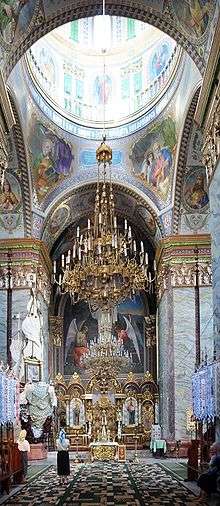
- Major events: Christianization of Kievan Rus', Ruthenia, Conversion of Kholm Eparchy
- Western Ukrainian Clergy: List of Major Archbishops of Kiev-Galicia and List of Metropolitans and Patriarchs of Kiev, Andrey Sheptytsky, Yosyf Slipyi, Hryhoriy Khomyshyn, Josaphata Hordashevska
- Dzhublyk
- Supporting organizations: Ukrainian Catholic University, Ukraine prison ministry, Priestly Society of Saint Josaphat
- Related organizations: Ruthenian Catholic Church (Greek Catholic Eparchy of Mukachevo), Belarusian Greek Catholic Church
- Autocephaly of the Orthodox Church of Ukraine
- Prairie cathedral
References
- Second Sunday of the Great Fast Gregory Palamas
- Synod of the Ukrainian Catholic Church
- Major Archbishop Sviatoslav: Pope wants Ukrainian Greek-Catholic Church to develop and flourish
- "Склад і територія". ugcc.ua. Archived from the original on 30 August 2019. Retrieved 23 August 2019.
- Church Union of Berestia. Encyclopedia of Ukraine
- The Ukrainian Greek-Catholic Church’s Name. St Sophia Church website
- Canonical aspects. Encyclopedia of Ukraine
- "Склад і територія". ugcc.ua. Retrieved 23 August 2019.
- Sas, P.M. Articles for Pacification of Ruthenian People (ПУНКТИ ДЛЯ ЗАСПОКОЄННЯ РУСЬКОГО НАРОДУ). Encyclopedia of History of Ukraine
- Yasinovsky, Yu. Greek-Catholic Metropolitan Archdiocese in Galicia (ГАЛИЦЬКА ГРЕКО-КАТОЛИЦЬКА МИТРОПОЛІЯ). Encyclopedia of History of Ukraine. 2004
- Dzyuba, O.M. Kiev Uniate Metropolitan (КИЇВСЬКА УНІЙНА МИТРОПОЛІЯ). Encyclopedia of History of Ukraine
- "Iosif Semashko : The Blackwell Dictionary of Eastern Christianity : Blackwell Reference Online". Blackwellreference.com. Retrieved 11 May 2011.
- Herbermann, Charles, ed. (1913). . Catholic Encyclopedia. New York: Robert Appleton Company.
- St. Nicholas Ukrainian Catholic Parish in Winnipeg, Historical Timeline of the Basilian Order of St. Josaphat
- Himka, John Paul. (1999). Religion and Nationality in Western Ukraine. McGill-Queen's University Press: Montreal and Kingston. Pg. 6.
- John-Paul Himka. (1986). The Greek Catholic Church and Ukrainian Society in Austrian Galicia. Cambridge, MA: Harvard University Press.
- Himka, John Paul. (1999). Religion and Nationality in Western Ukraine. McGill-Queen's University Press: Montreal and Kingston. Pg. 10
- The Very Reverend Philip Ruh, O.M.I. Priest, Architect and Builder of about 40 Ukrainian Catholic Churches URL accessed 9 February 2007
- Magosci, P. (1989). Morality and Reality: the Life and Times of Andrei Sheptytsky. Edmonton, Alberta: Canadian Institute of Ukrainian Studies, University of Alberta.
- Soviet-Era Documents Shed Light On Suppression Of Ukrainian Catholic Church Soviet-Era Documents Shed Light On Suppression Of Ukrainian Catholic Church, Radio Free Europe/Radio Liberty, 7 August 2009
- "Soviet repression of the Ukrainian Catholic Church." Department of State Bulletin 87 (1987)
- "The Ukrainian Greek Catholics: A Historical Survey", by Religious Information Service of Ukraine
- St Joseph Ukrainian Catholic Church Homepage Archived 23 January 2016 at the Wayback Machine
- "Josyf Ivanovycè Cardinal Slipyj (Slipiy)". Catholic-Hierarchy.org. David M. Cheney. Retrieved 21 January 2015.
- Andrew Wilson, The Ukrainians: Unexpected Nation, p. 246, Yale University Press, 2002, ISBN 0-300-09309-8
- Nathaniel Davis, A Long Walk to Church: A Contemporary History of Russian Orthodoxy, p. 75, Westview Press, 2003, ISBN 0-8133-4067-5
- "Особливості Релігійного і Церковно-Релігійного Самовизначення Українських Громадян: Тенденції 2010-2018рр." [The religion and church-denomination of Ukrainian citizens as self-determined: trends 2010-2018] (PDF), Razumkov Centre, p. 13, 26 April 2018, retrieved 12 October 2018
- "Соціологічне опитування: Віруючим якої церкви, конфесії Ви себе вважаєте?" [Sociological survey: which church or religious denomination do you believe in yourself?], Razumkov Centre, 4 June 2006, archived from the original on 16 April 2010, retrieved 12 October 2018
- "Survey Conducted on Church Membership in Ukraine". Religious Information Service of Ukraine. 29 January 2007. Archived from the original on 27 September 2007. Retrieved 12 October 2018.
- "70 Percent of Ukrainians Religious, Survey Shows". 17 June 2004. Archived from the original on 21 July 2011. Retrieved 12 October 2018.
- Более 70% украинцев считают себя верующими – опрос [A poll says that more than 70% of Ukrainians consider themselves to be believers], UNIAN, 23 November 2016, retrieved 12 October 2018
- "Religious preferences of the population of Ukraine". Sociology poll by Razumkov Centre, SOCIS, Rating and KIIS about the religious situation in Ukraine (2015)The survey sample was 25000 people, excluded Crimea, so 1000 people for oblast.
- https://www.vaticannews.va/en/pope/news/2019-07/pope-to-ukrainian-greek-catholics-i-carry-you-in-my-heart.html
- Catholic World News, 21 November 2007. Ukrainian priest excommunicated
- Molodyko, V. Tragic fate of the Saint Trinity Church (Трагічні долі Троїцької церкви). 18 October 2003.
- The UGCC created three new metropolia in Ukraine. The Ukrainian Week. 8 November 2011
- Ronald Roberson. "The Eastern Catholic Churches 2014" (PDF). Catholic Near East Welfare Association. Retrieved 10 January 2015. Information sourced from Annuario Pontificio 2014 edition.
- "Male Monastic Orders and Congregations", The Ukrainian Greek Catholic Church Official Website, 2006, archived from the original on 16 August 2006
Further reading
- Articles in Zerkalo Nedeli (Mirror Weekly): "Moscow, Vatican and an unpredictable weather in Ukraine", March 2004,in Ukrainian and in Russian
- "Account of the history of the Unia and its disestablishment in 19th Century Russia" in Russian
- Orientales Omnes Ecclesias, Encyclical on the Reunion of the Ruthenian Church with Rome His Holiness Pope Pius XII, Promulgated on December 23, 1945.
- Herbermann, Charles, ed. (1913). . Catholic Encyclopedia. New York: Robert Appleton Company.
- Gudziak, Borys A. (2001). Crisis and Reform: The Kyivan Metropolitanate, The Patriarchate of Constantinople, and the Genesis of the Union of Brest. Harvard University Press. Cambridge, MA.
- Chirovsky, A. As pope and Russian patriarch meet, Ukraine fears a “shaky” Vatican. The Ukrainian Weekly. 19 February 2016.
External links
| Wikimedia Commons has media related to Ukrainian Greek Catholic Church. |
- Official website
- Live video broadcasts of Ukrainian Catholic Divine Liturgy (and recordings)
- Official website of the Kyiv Archeparchy]
- St Joseph Ukrainian Catholic Church
- St. Elias Ukrainian Catholic Church
- St. John the Baptist Ukrainian Catholic Church
- At the Service of Church Unity
- Information website of the Religious Information Service of Ukraine
- Article on the UGCC by Ronald Roberson on the CNEWA web site
- www.damian-hungs.de (in German)
